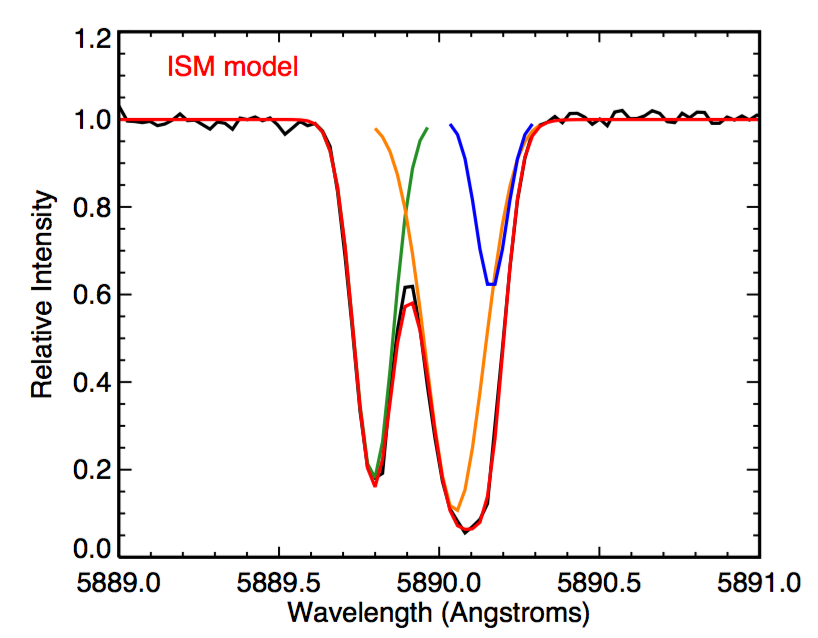If you’re looking for a guide to this series, click here.
Last time, I looked at the infrared constraints on solutions to the puzzle of Boyajian’s Star. This time, let’s look at other constraints.
Boyajian and others have noted that the deepest dips seem to have some patterns to them.
A 2 year period?
For instance, two of the deepest dips occur 2.000 years apart, which is an awfully precise number to be mere coincidence.
But, coincidence it is: remember that Kepler does not orbit the Earth, it orbits the Sun, and it does so in an Earth-trailing orbit, meaning that it has a different orbital period than the Earth! So the relevant year is not an Earth year, but a Kepler year. This makes those two dips’ interval less suspiciously precise: they are 1.96 Kepler years apart. Also, if the Kepler orbit were responsible for those two dips, then one would also expect to have seen dips 0.98 Kepler years before and after the first of those—and we don’t.
A 48.4 day period?
Another suspicious bit of timing is that many of the deepest dips seem to occur with an interval of 24.2 days. Boyajian noted that this looks like a 48.4 day orbital period, in which something luminous blocks the star every 48.4 days, and is itself blocked half a cycle later as it goes behind Boyajian’s Star.
I think it was Mark Conde who first pointed out to me that this was probably a coincidence. I redid the calculation myself, and asked: if the dip times were perfectly random, how often would we be able to find a similarly strong coincidence? I drew six times of dips randomly 10,000 times and hunted for periods that lined up at least as well as the 24.2 day coincidences in the timings of the six actual dips in the Kepler data. Over 15% of the time, I found better coincidences, and among all of the best coincidences I found, the median period was 20.8 days.
It other words, with only 6 dips, it’s quite common to see phantom periodicities if you check enough periods. True, these are a bit better lined up than random, but that’s probably why they were noticed and I did this analysis in the first place.
So, I don’t think there is any reason to suspect that the dips are periodic. That doesn’t mean they’re not, just that we should not feel constrained by any periodicities when looking for solutions to the puzzle.
Sodium absorption and reddening
Boyajian’s Star’s sodium lines are very broad because the star is rotating rapidly. Between us and the star, there are clouds of neutral gas, and this gas contains sodium and dust (and lots of other stuff). As a result, the dust makes the star a bit too faint in the bluer wavelengths, and the sodium absorbs light at its characteristic wavelengths near 590 nm. This is not unusual: at the nominal distance of Boyajian’s Star (450 pc) we expect there to be plenty of this interstellar material.
The reddening from dust makes the blue wavelengths about 10% fainter than it should be compared to green-ish wavelengths (we write E(B-V) = 0.1). This also implies that about 35% of all of the visible light from the star in our direction is attenuated by dust before it reaches Earth.
We can also use the sodium lines to “find” the source of this dust, presuming that the sodium and the dust go together (a reasonable but imprecise assumption). Here is what the sodium lines look like, (analysis courtesy of (newly-minted-PhD) Jason Curtis, Keck/HIRES spectrum courtesy of B.J. Fulton and Andrew Howard):

Boyajian’s Star’s sodium line. The big “bowl” is the star’s absorption line, broadened by its rotation. The narrow features are due to intervening sodium gas.

The narrow sodium features, modeled as absorption from three clouds of sodium between us and Boyajian’s Star by Jason Curtis.
The total sodium absorption we see (420 mÅ for the experts) translates to roughly E(B-V)=0.1, which is exactly what we see, so it all hangs together: at the time of these observations (2015) the sodium between us and Boyajian’s Star an the reddening were consistent.
This has implications for the long-term dimming seen by Shaefer and Montet & Simon: if it is due to dust and neutral gas, then these clouds are the ones responsible. Note that none of the lines are centered on Boyajian’s Star’s line: this means they have significant line-of-sight motion with respect to Boyajian’s Star, making it unlikely (I would argue) that they are in clouds orbiting the star. The RV of Boyajian’s Star is +4 km/s, and the red-most cloud is offset by ~10 km/s, so it has ~5 km/s motion with respect to the solar system barycenter. This all argues to me that the clouds are what they appear to be and what we would guess they would be if Boyajian’s Star were not so weird: ordinary gas and dust in the interstellar medium.
Next time: what are the stars near Boyajain’s Star doing? Then, on to the hypotheses!

When you rule out all NATURAL explanations, then you are left with the Science Fiction explanations.